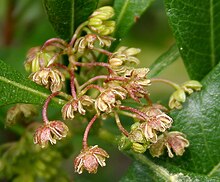Dodonaea viscosa
| Dodonaea viscosa | |
|---|---|
 |
|
| flowers | |
| Scientific classification | |
| Kingdom: | Plantae |
| (unranked): | Angiosperms |
| (unranked): | Eudicots |
| (unranked): | Rosids |
| Order: | Sapindales |
| Family: | Sapindaceae |
| Genus: | Dodonaea |
| Species: | D. viscosa |
| Binomial name | |
|
Dodonaea viscosa Jacq. |
|
Dodonaea viscosa is a species of flowering plant in the soapberry family, Sapindaceae, that has a cosmopolitan distribution in tropical, subtropical and warm temperate regions of Africa, the Americas, southern Asia and Australasia.
D. viscosa is a shrub growing to 1–3 m (3.3–9.8 ft) tall, rarely a small tree to 9 m (30 ft) tall. The leaves are variable in shape: generally obovate but some of them are lanceolate, often sessile, 4–7.5 cm (1.6–3.0 in) long and 1–1.5 cm (0.39–0.59 in) broad, alternate in arrangement, and secrete a resinous substance. Many specimens have a pointed or rounded apex. Leaf base is extended. Leaf texture is leathery, tough, but also pliable. Midribs are medium becoming less visible close to the apex. Secondary veins are thin, generally indistinct; Veins: often 6 to 10 pairs, indifferently opposite, subopposite, and alternate, camptodrome. Venation branches from the midrib at different angles, which may vary from 12° to 70°. The basal veins are very ascending in some plants: the angle of divergence may be close to 45°. The basal secondary venation branches from a point near the base of the main vein and becomes parallel with the leaf margin, with the distance of 1 millimeter to 2 millimeters from the edges. Margins are usually toothed or undulating. The remaining secondary veins lay at regular intervals with flowers usually growing at the branches’ ends. The flowers are yellow to orange-red and produced in panicles about 2.5 cm (0.98 in) in length. The flowers may be only male or female ones, and one plant bears either male or female flowers. However, sometimes they are observed to bear flowers of both sexes. The pollen is transported by anemophily. It is believed that D. viscosa flowers lack petals during evolution to increase exposure to the wind. The fruit is a capsule 1.5 cm (0.59 in) broad, red ripening brown, with two to four wings.
...
Wikipedia
